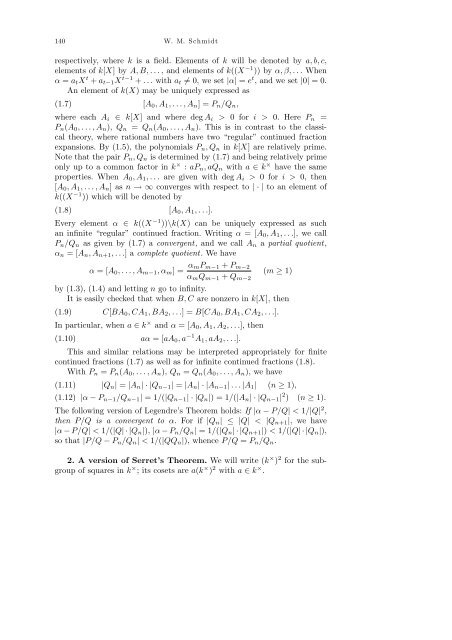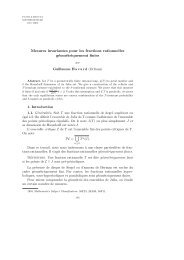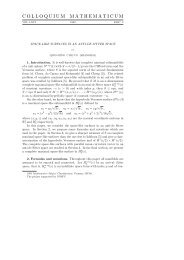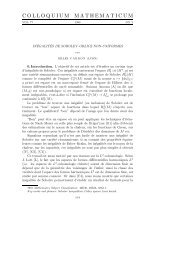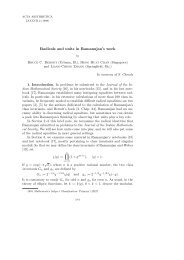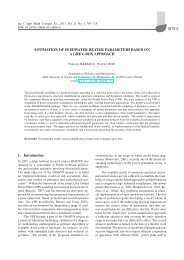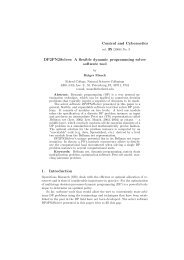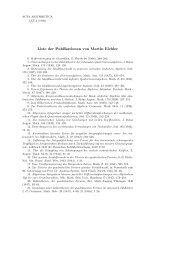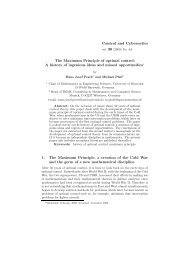On continued fractions and diophantine approximation in power ...
On continued fractions and diophantine approximation in power ...
On continued fractions and diophantine approximation in power ...
Create successful ePaper yourself
Turn your PDF publications into a flip-book with our unique Google optimized e-Paper software.
140 W. M. Schmidt<br />
respectively, where k is a field. Elements of k will be denoted by a, b, c,<br />
elements of k[X] by A, B, . . . , <strong>and</strong> elements of k((X −1 )) by α, β, . . . When<br />
α = atX t + at−1X t−1 + . . . with at = 0, we set |α| = e t , <strong>and</strong> we set |0| = 0.<br />
An element of k(X) may be uniquely expressed as<br />
(1.7) [A0, A1, . . . , An] = Pn/Qn,<br />
where each Ai ∈ k[X] <strong>and</strong> where deg Ai > 0 for i > 0. Here Pn =<br />
Pn(A0, . . . , An), Qn = Qn(A0, . . . , An). This is <strong>in</strong> contrast to the classical<br />
theory, where rational numbers have two “regular” <strong>cont<strong>in</strong>ued</strong> fraction<br />
expansions. By (1.5), the polynomials Pn, Qn <strong>in</strong> k[X] are relatively prime.<br />
Note that the pair Pn, Qn is determ<strong>in</strong>ed by (1.7) <strong>and</strong> be<strong>in</strong>g relatively prime<br />
only up to a common factor <strong>in</strong> k × : aPn, aQn with a ∈ k × have the same<br />
properties. When A0, A1, . . . are given with deg Ai > 0 for i > 0, then<br />
[A0, A1, . . . , An] as n → ∞ converges with respect to | · | to an element of<br />
k((X −1 )) which will be denoted by<br />
(1.8) [A0, A1, . . .].<br />
Every element α ∈ k((X −1 ))\k(X) can be uniquely expressed as such<br />
an <strong>in</strong>f<strong>in</strong>ite “regular” <strong>cont<strong>in</strong>ued</strong> fraction. Writ<strong>in</strong>g α = [A0, A1, . . .], we call<br />
Pn/Qn as given by (1.7) a convergent, <strong>and</strong> we call An a partial quotient,<br />
αn = [An, An+1, . . .] a complete quotient. We have<br />
α = [A0, . . . , Am−1, αm] = αmPm−1 + Pm−2<br />
(m ≥ 1)<br />
αmQm−1 + Qm−2<br />
by (1.3), (1.4) <strong>and</strong> lett<strong>in</strong>g n go to <strong>in</strong>f<strong>in</strong>ity.<br />
It is easily checked that when B, C are nonzero <strong>in</strong> k[X], then<br />
(1.9) C[BA0, CA1, BA2, . . .] = B[CA0, BA1, CA2, . . .].<br />
In particular, when a ∈ k × <strong>and</strong> α = [A0, A1, A2, . . .], then<br />
(1.10) aα = [aA0, a −1 A1, aA2, . . .].<br />
This <strong>and</strong> similar relations may be <strong>in</strong>terpreted appropriately for f<strong>in</strong>ite<br />
<strong>cont<strong>in</strong>ued</strong> <strong>fractions</strong> (1.7) as well as for <strong>in</strong>f<strong>in</strong>ite <strong>cont<strong>in</strong>ued</strong> <strong>fractions</strong> (1.8).<br />
With Pn = Pn(A0, . . . , An), Qn = Qn(A0, . . . , An), we have<br />
(1.11)<br />
(1.12)<br />
|Qn| = |An| · |Qn−1| = |An| · |An−1| . . . |A1| (n ≥ 1),<br />
|α − Pn−1/Qn−1| = 1/(|Qn−1| · |Qn|) = 1/(|An| · |Qn−1| 2 ) (n ≥ 1).<br />
The follow<strong>in</strong>g version of Legendre’s Theorem holds: If |α − P/Q| < 1/|Q| 2 ,<br />
then P/Q is a convergent to α. For if |Qn| ≤ |Q| < |Qn+1|, we have<br />
|α − P/Q| < 1/(|Q| · |Qn|), |α − Pn/Qn| = 1/(|Qn| · |Qn+1|) < 1/(|Q| · |Qn|),<br />
so that |P/Q − Pn/Qn| < 1/(|QQn|), whence P/Q = Pn/Qn.<br />
2. A version of Serret’s Theorem. We will write (k × ) 2 for the subgroup<br />
of squares <strong>in</strong> k × ; its cosets are a(k × ) 2 with a ∈ k × .


